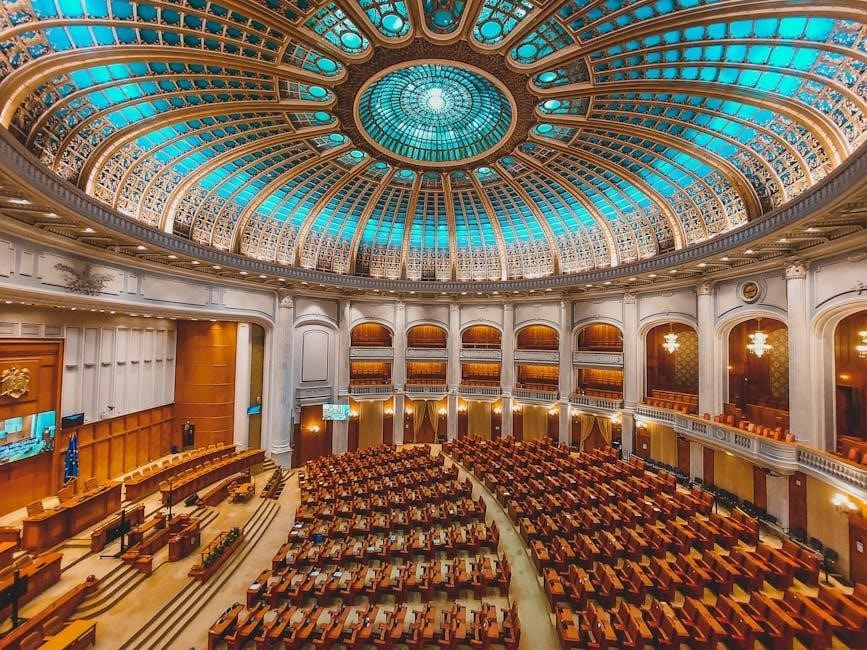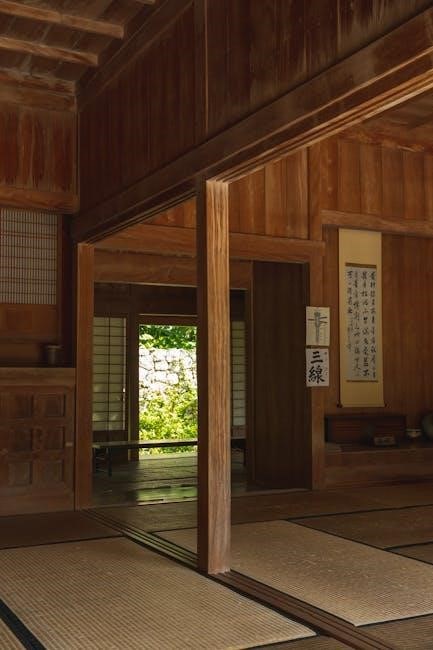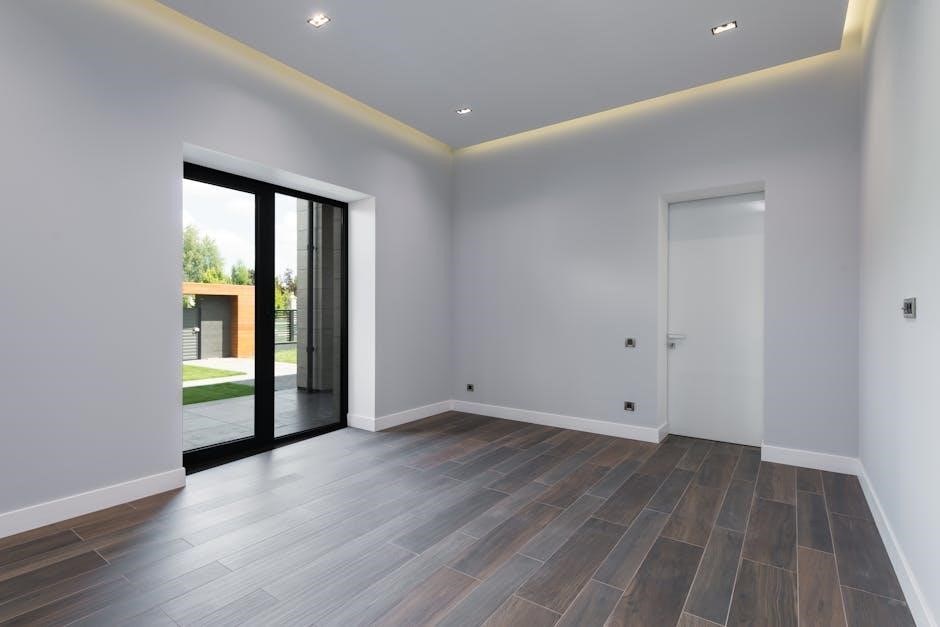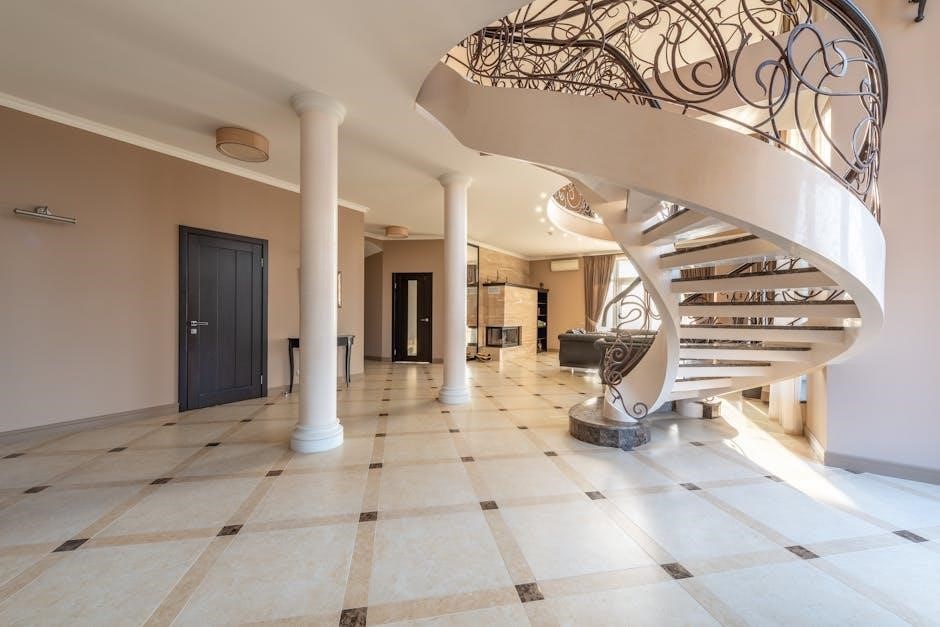A guide hall is a versatile space used for meetings, conferences, and community activities, blending historical significance with modern functionality to foster collaboration and engagement․
It serves as a hub for various events, showcasing its adaptability and importance in both historical and contemporary contexts․
1․1 Definition and Purpose
A guide hall is a central meeting space designed to facilitate gatherings, events, and activities for various groups and communities․
It serves as a versatile venue for conferences, seminars, and networking, fostering collaboration and idea-sharing․
Historically, guide halls have been integral to community service, hosting events like Girlguiding NZ activities and other social engagements․
Their purpose extends to providing a formal setting for presentations and discussions, making them essential for both business and communal needs․
The primary function of a guide hall is to create an environment that encourages productivity, engagement, and connectivity among participants․
1․2 Historical Background
Guide halls trace their origins to medieval Europe, where guildhalls served as administrative centers for trade guilds and municipalities․
These historic buildings were primarily used for tax collection, meetings, and storing records, reflecting their role in governance and commerce․
Over time, guide halls evolved to accommodate community needs, transitioning into spaces for social gatherings and educational activities․
The Roby Street Guide Hall, for instance, originally functioned as a local school, illustrating its adaptability and enduring relevance․
Historically, these halls have played a pivotal role in fostering community engagement and organizational activities, a legacy that continues today․
1․3 Modern Applications
Today, guide halls serve as versatile spaces for diverse activities, catering to both community and professional needs․
They are widely used for conferences, seminars, and product launches, providing a formal setting for presentations and idea sharing․
Additionally, these halls host networking events, fostering collaboration and engagement among attendees․
In scientific contexts, guide halls are utilized for advanced research, such as cold neutron studies and experiments with devices like the MAGIK reflectometer․
This adaptability highlights their enduring relevance in modern society, making them indispensable for various purposes․

Types of Guide Halls
2․1 Town Hall Meetings
Town hall meetings are informal gatherings where individuals discuss community or organizational issues․
They foster open communication, allowing participants to voice opinions and engage in collaborative discussions;
These meetings are essential for transparency, ensuring that all voices are heard and concerns addressed․
They are widely used in both public and private sectors to build consensus and drive decision-making․
The informal setting encourages active participation, making them a vital tool for community engagement and problem-solving․
Town halls remain a cornerstone of democratic processes, promoting inclusivity and collective action․
Town hall meetings are informal gatherings where individuals discuss community or organizational issues․
They foster open communication, allowing participants to voice opinions and engage in collaborative discussions․
These meetings are essential for transparency, ensuring that all voices are heard and concerns addressed․
They are widely used in both public and private sectors to build consensus and drive decision-making․
2․2 Cold Guide Hall
A cold guide hall is a specialized facility utilizing cold neutrons for advanced scientific research․
These halls are equipped with instruments designed to study complex soft matter, such as proteins and polymers․
Cold neutrons, with lower energy, provide unique insights into material structures and dynamics․
This technology is crucial for exploring thin films and understanding their properties․
The MAGIK reflectometer is one such tool used in these halls to analyze surfaces and interfaces․
Cold guide halls play a vital role in scientific discovery, offering precise data for various applications․
Their functionality is tailored to support cutting-edge research in physics and materials science․
2․3 Guildhall (Historical)
A guildhall, or guild house, is a historical building originally used by guilds or corporations for meetings and tax collection․
These structures were central to medieval European towns, serving as hubs for governance and commerce․
Guildhalls often housed administrative offices and were symbols of a guild’s prestige and influence․
They played a significant role in the economic and social life of municipalities․
Historically, guildhalls were also used for storing records and hosting gatherings for guild members․
Their architecture varied, reflecting the wealth and status of the guild they represented․
Today, many guildhalls remain as historical landmarks, preserving the legacy of medieval trade and governance․

Uses of Guide Halls
Guide halls serve as versatile venues for conferences, seminars, product launches, and networking events․
They are ideal for fostering collaboration, sharing ideas, and hosting community activities․
Their adaptability makes them essential spaces for both formal and informal gatherings․
Guide halls are widely used for events that require focused engagement and interaction․
They play a key role in promoting productivity and connectivity in various settings․
3․1 Conferences and Seminars
Guide halls are widely utilized for hosting conferences and seminars, providing a structured environment for knowledge sharing and professional development․
These events often feature expert speakers, panel discussions, and interactive sessions, leveraging the hall’s formal setting to enhance engagement․
The spacious layout and amenities of guide halls make them ideal for accommodating large audiences and fostering collaborative learning experiences․
Conferences and seminars held in guide halls often focus on specific themes, such as business strategies, community development, or scientific research․
The ability to organize seating, audiovisual equipment, and networking areas ensures that these events are both productive and impactful․
3․2 Product Launches and Presentations
Guide halls are increasingly popular venues for product launches and presentations, offering a professional and engaging environment for showcasing innovations․
The spacious and well-equipped layout of these halls allows for seamless demonstrations, while their formal setting enhances credibility and audience impact․
Companies leverage the hall’s amenities, such as stages, audiovisual systems, and flexible seating, to create immersive experiences․
Product launches in guide halls often feature interactive displays, live demos, and Q&A sessions, fostering direct engagement with attendees․
The ability to customize the space to align with brand aesthetics further elevates the event’s success, making guide halls a strategic choice for impactful presentations․
3․3 Networking Events
Guide halls are ideal venues for networking events, providing open spaces that encourage interaction and collaboration․
Their flexible layouts accommodate various event formats, from casual mixers to structured meet-and-greets, fostering meaningful connections․
The professional yet welcoming atmosphere of guide halls makes them perfect for industry professionals, entrepreneurs, and community groups to connect․
Amenities like Wi-Fi, breakout rooms, and catering options further enhance the networking experience․
These events often feature keynote speakers, panel discussions, and icebreakers, creating opportunities for attendees to share ideas and build relationships․
Guide halls play a pivotal role in facilitating collaboration and driving professional growth through well-organized networking events․

Guide Hall in Business Context
Guide halls serve as central spaces for business activities, fostering productivity and collaboration․
They provide formal settings for presentations, idea sharing, and strategic planning, making them essential for corporate events and professional gatherings․
4․1 Boosting Productivity
Guide halls play a crucial role in enhancing workplace productivity by providing a dedicated space for focused activities․
They offer a distraction-free environment, promoting concentration and efficiency during meetings, seminars, and collaborative projects․
The structured layout and availability of essential tools ensure that teams can work effectively, fostering innovation and achieving organizational goals․
Moreover, the formal setting encourages accountability and prioritization, making guide halls an invaluable asset for businesses aiming to optimize performance and deliver results․
4․2 Idea Sharing and Collaboration
Guide halls serve as dynamic spaces for fostering idea sharing and collaboration among individuals and teams․
Their open layouts and specialized tools create an environment where creativity and communication thrive․
Whether through brainstorming sessions, workshops, or informal discussions, guide halls encourage the exchange of ideas․
They often feature amenities like whiteboards, projectors, and flexible seating, which facilitate teamwork and innovation․
By breaking down silos and fostering open dialogue, guide halls become hubs for collaborative problem-solving and strategic planning․
This collaborative atmosphere not only enhances teamwork but also drives collective progress and shared success․
4․4 Formal Setting for Presentations
A guide hall provides a formal setting ideal for professional presentations, enabling organizations to deliver structured and impactful messages․
The professional atmosphere ensures clarity and focus, making it easier to convey key information to attendees․
Advanced audiovisual equipment and seating arrangements further enhance the experience, allowing presenters to engage audiences effectively․
This setting is particularly beneficial for business meetings, product launches, and seminars, where a polished and organized approach is essential․
By offering a dedicated space for formal presentations, guide halls play a crucial role in facilitating clear communication and professional excellence․

Guild Halls in Gaming
Guild halls in gaming serve as customizable bases, offering players strategic advantages and community-building opportunities, as seen in Guild Wars 2: Heart of Thorns․
5․1 Guild Halls in Guild Wars 2: Heart of Thorns
Guild halls in Guild Wars 2: Heart of Thorns are expansive bases that serve as hubs for guild activities, offering customization options and strategic advantages․
These halls allow players to decorate, upgrade, and manage their spaces, fostering a sense of community and collaboration among members․
Introduced in the expansion, they provide unique features like NPC interactions, resource upgrades, and access to special events, enhancing the overall gaming experience․
Players can personalize their halls with various decorations and utilities, making them functional and reflective of their guild’s identity․
5․2 Features and Customization
Guild halls in Guild Wars 2: Heart of Thorns offer extensive customization options, allowing players to personalize their spaces with decorative items, NPCs, and functional upgrades․
Players can accessorize their halls with unique furnishings, banners, and trophies, creating a distinct identity for their guild․
Customization extends to layouts, with areas like gardens, workshops, and grand halls, enabling tailored environments for various activities․
These features enhance both aesthetics and functionality, providing a sense of ownership and pride within the game․
5․3 Strategic Importance
Guild halls hold significant strategic value in Guild Wars 2: Heart of Thorns, serving as central hubs for planning and executing missions․
They provide resources and amenities that enhance guild operations, fostering coordination among members․
Strategic placement of guild halls can offer control over key territories, ensuring access to valuable resources and tactical advantages․
These halls are integral to progressing through the game, making them essential for any ambitious guild aiming to thrive in Tyria․
Multi-Purpose Halls
Multi-purpose halls are versatile spaces designed to accommodate a wide range of activities, from conferences to social gatherings, offering flexibility and practicality for diverse needs and events․
6․1 Different Sizes and Designs
Multi-purpose halls come in various sizes and designs, catering to diverse needs․ From compact spaces for intimate gatherings to large venues for grand events, their flexibility is unmatched․ Some halls feature modular seating arrangements, while others offer open layouts for customization․ Designs often incorporate materials like wood or metal, blending aesthetics with functionality․ Additionally, specialized features such as soundproofing, adjustable lighting, and state-of-the-art technology enhance their versatility․ This variety ensures that multi-purpose halls can seamlessly adapt to host conferences, weddings, exhibitions, or community events, making them indispensable for modern societal requirements․
6․2 Versatility in Usage
Guide halls are renowned for their adaptability, accommodating a wide range of activities seamlessly․ They serve as ideal venues for conferences, seminars, and product launches, while also hosting community events and networking gatherings․ Their design allows for easy transformation to suit different purposes, making them indispensable for both formal and informal settings․ Whether for business presentations, social events, or educational workshops, guide halls provide a flexible space that caters to diverse needs․ This versatility ensures they remain central to community and organizational activities, offering a practical solution for various events and gatherings․
6․3 Architecture and Layout
Guide halls often feature modern, functional architecture designed to accommodate diverse activities․ Open spaces, modular seating arrangements, and adjustable layouts enhance versatility, making them suitable for various events․ Many guide halls incorporate amenities like restrooms, storage areas, and kitchenettes to support multi-purpose usage; The design frequently emphasizes accessibility and sustainability, with natural lighting and energy-efficient systems․ These structural elements ensure guide halls are both practical and inviting, catering to the needs of different users while maintaining a welcoming atmosphere for community and organizational gatherings․

Guide Hall in Community Service
Guide halls serve as vital spaces for community activities, hosting events like Girlguiding NZ meetings, U3A Pilates, and Brendoncare social clubs, fostering social connections and support networks․
7․1 Role in Community Activities
Guide halls play a pivotal role in community activities by providing a welcoming space for diverse gatherings․ They host events such as workshops, social clubs, and educational programs, fostering inclusivity and social bonding․ These halls are often utilized by organizations like Girlguiding NZ, which focuses on youth development, and groups like U3A Pilates and Brendoncare, catering to older adults․ By offering a neutral and accessible environment, guide halls strengthen community ties and support the well-being of residents, making them indispensable to local social fabric and collective engagement․

7․2 Girlguiding NZ Activities
Girlguiding NZ activities are a cornerstone of community engagement within guide halls․ These events focus on empowering young girls through skill-building workshops, leadership training, and team-building exercises․ The halls provide a safe and inspiring environment for girls to develop confidence and camaraderie․ Activities range from outdoor adventures to creative projects, fostering personal growth and social responsibility․ By utilizing guide halls, Girlguiding NZ ensures that its programs are accessible and impactful, contributing to the development of future community leaders while maintaining the halls’ vibrant role in local life․
7․3 Other Community-Based Activities
Beyond Girlguiding NZ, guide halls host a variety of community-based activities, such as U3A Pilates classes and Brendoncare social clubs for seniors․ These events promote social interaction, health, and well-being among participants․ The halls also serve as venues for educational workshops, cultural events, and recreational gatherings, making them integral to community cohesion․ By accommodating diverse activities, guide halls foster inclusivity and support for all age groups, ensuring their role as vibrant community hubs remains vital and relevant in modern society․

Scientific Applications
Guide halls are utilized in scientific research, particularly for cold neutron studies and exploring thin films․ The MAGIK reflectometer is a key tool in these advanced scientific investigations․
8․1 Cold Neutron Research
Guide halls house specialized instruments for cold neutron research, utilizing low-energy neutrons to study complex materials like proteins and polymers․ This technique provides detailed insights into molecular structures, enhancing understanding in materials science and soft matter dynamics․ By leveraging cold neutrons, researchers can explore delicate samples without damaging them, making it invaluable for advanced scientific investigations․ The application of cold neutron research in guide halls significantly contributes to breakthroughs in various fields, offering a unique tool for unraveling intricate scientific mysteries․
8․2 Exploring Thin Films
Guide halls facilitate cutting-edge research through advanced instruments like reflectometers, enabling the exploration of thin films․ These tools utilize cold neutrons to examine the structural properties of thin-layered materials․ By providing precise insights into surface and interface dynamics, researchers gain valuable data for improving material performance․ This technique is particularly useful in understanding nanoscale structures, which are critical in advancing technologies․ The non-invasive nature of neutron analysis makes it ideal for delicate samples, further enhancing its utility in scientific investigations․
8․3 MAGIK Reflectometer Usage
The MAGIK Reflectometer is a specialized instrument housed within guide halls, designed to study thin films and nanostructures using cold neutron technology․ Scheduled to become operational shortly after its introduction, it provides researchers with a powerful tool to examine surface and interfacial properties․ This non-invasive technique allows for precise analysis without damaging samples, making it invaluable in materials science and nanotechnology research․ The reflectometer’s advanced capabilities enable deeper insights into material behavior, contributing to breakthroughs in various scientific fields․

Booking and Management
Effective booking and management are crucial for guide halls to function smoothly as community hubs․
They ensure spaces are utilized efficiently and maintained properly for various events and activities․
9․1 Booking Process
The booking process for guide halls typically involves contacting the management team through email or an online form․
Prospective users must provide event details, preferred dates, and contact information․
Availability is checked, and a confirmation is issued upon successful booking․
Some halls require deposits or signed agreements to secure reservations․
It’s essential to review hall policies, including setup requirements and noise restrictions, to ensure a smooth experience․
Inquiries can also be made via phone for immediate assistance․
9․2 Management Tips
Effective management of guide halls involves organized scheduling and clear communication with users․
Regular inspections ensure cleanliness and functionality, while maintaining a detailed booking calendar prevents overbooking․
Promoting the hall through community channels can increase utilization and support․
Implementing eco-friendly practices, like energy-efficient lighting, enhances sustainability․
Encouraging feedback from users helps identify areas for improvement․
Additionally, leveraging tools like online booking systems streamlines operations and improves efficiency․
transparency in pricing and policies fosters trust and long-term relationships with the community․
9․3 Maintenance and Upkeep
Regular maintenance is essential to ensure the longevity and functionality of guide halls․
This includes inspecting facilities, cleaning, and addressing repairs promptly to prevent deterioration․
Landscaping and exterior upkeep maintain the hall’s visual appeal․
Seasonal deep cleaning of high-traffic areas, such as kitchens and restrooms, is recommended․
Proper waste disposal and recycling practices should be enforced;
Additionally, routine checks on electrical and plumbing systems help prevent unexpected issues․
A well-maintained guide hall not only enhances user experience but also preserves its value for future generations․

The Roby Street Guide Hall
The Roby Street Guide Hall, located on Durham Green in Te Atatu Peninsula, is a former local school now serving as a community hub for various activities․
It hosts events like Girlguiding NZ and other gatherings, making it a vital space for local engagement and connection․
10․1 Historical Background
The Roby Street Guide Hall, situated on Te Atatu Peninsula, originally served as a local school, reflecting its educational roots in the community․
Over the years, it transitioned into a multipurpose venue, preserving its historical charm while adapting to modern needs, making it a cherished landmark for local gatherings and events․
10․2 Current Usage
The Roby Street Guide Hall is actively used for various community activities, including Girlguiding NZ events, U3A Pilates sessions, and Brendoncare social clubs for seniors․
It serves as a vibrant hub for local gatherings, fostering social connections and supporting diverse interests within the community․
The hall’s versatility allows it to host meetings, workshops, and recreational events, making it an essential resource for residents of all ages․
10․3 Community Impact
The Roby Street Guide Hall significantly contributes to the community’s well-being by providing a space for social, educational, and recreational activities․
It fosters a sense of belonging among residents, offering platforms for diverse groups to connect and thrive․
From youth development through Girlguiding NZ to supporting seniors with social clubs, the hall enhances quality of life and community bonds․
Its role in hosting events and workshops also promotes local engagement and pride, making it a vital asset for the area’s social and cultural fabric․
Comments